_We may earn revenue from the products available on this page and participate in affiliate programs. Learn more ›
_
Best Overall
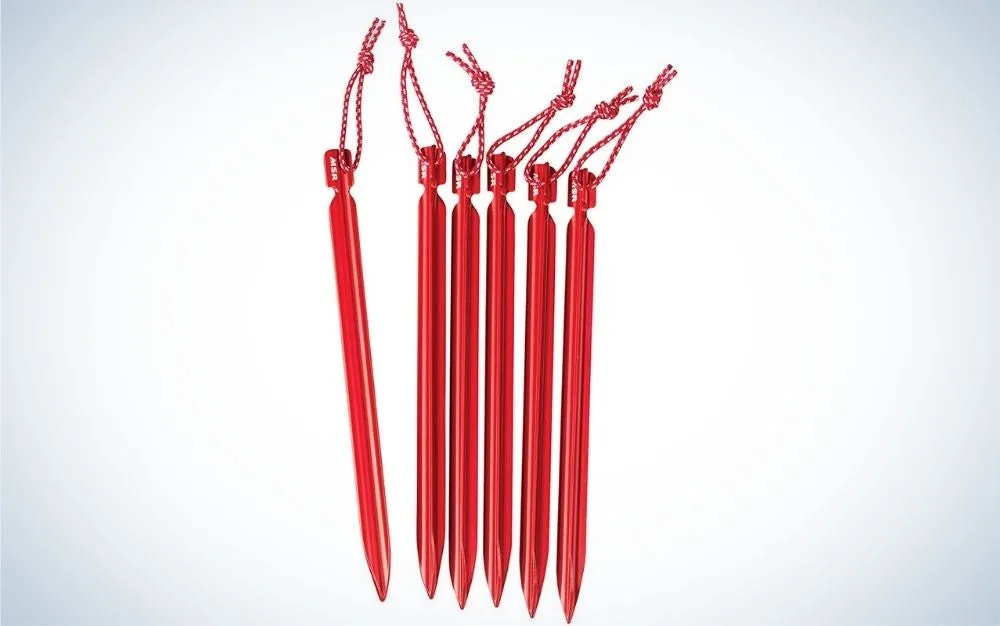
MSR Groundhog
LEARN MORE
Summary
The MSR Groundhog stakes are the best tent stakes on our list due to their durability, ease of use, and weight.
Best for Soft Ground
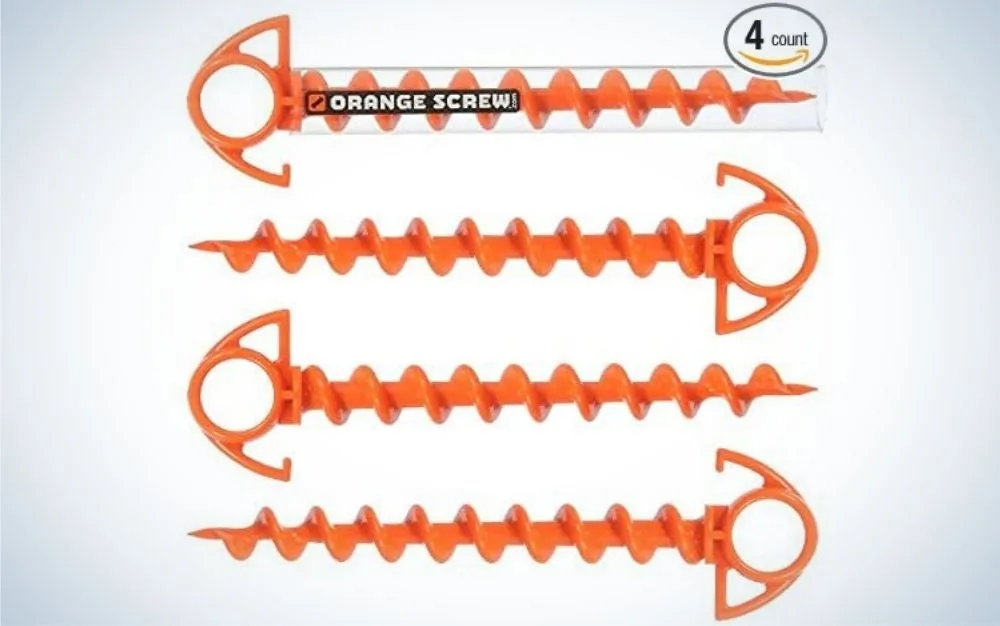
OrangeScrew Anchors
LEARN MORE
Summary
The Orange Screw Anchors are a unique and versatile tent stake that can be used for loose sediment as a strong and durable anchor.
Best Budget
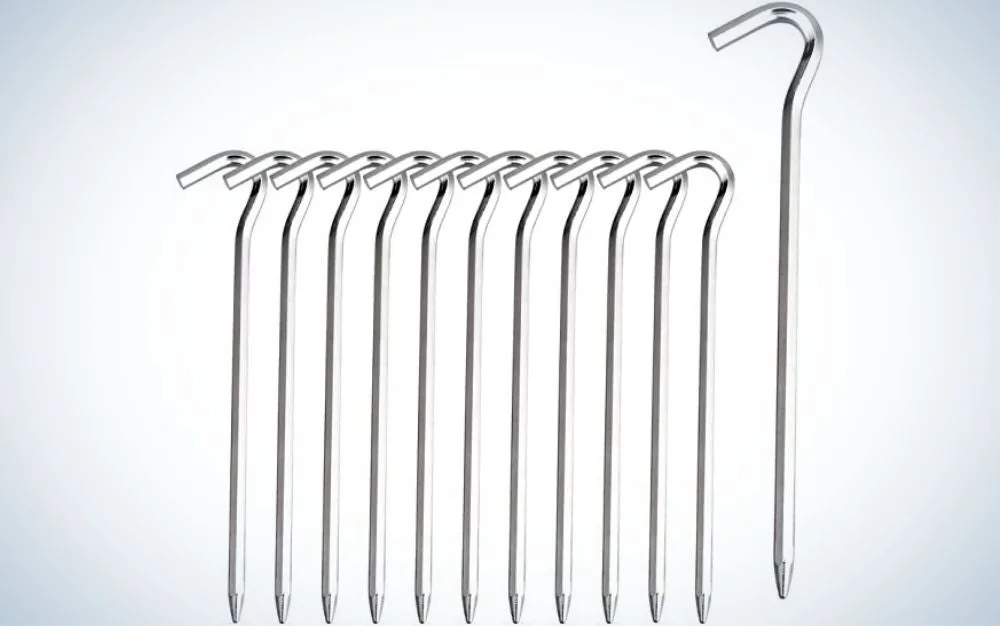
FANBFX Tent Pegs
LEARN MORE
Summary
The FANBFX Tent Pegs are a durable budget tent stake option that comes in large sets and are compatible with tents, canopies, and other shelters.
When we purchase a tent, most of them come with stock tent stakes. While I advocate for starting with what you have, some stock tent stakes don’t cut it. They can be flimsy and ill-suited for keeping a sturdy hold on your tent, especially when camping in special circumstances like on sand or snow.
The first step in deciding which tent stakes are suitable for your camping needs is to identify the intended use and the type of ground. Stakes or anchors that work best for soft ground like sand will not work well in rocky or hard ground areas. Your budget may also play a role in the types of stakes you buy. Whatever the case may be, we made sure to include a variety of options so you can find the best tent stakes for your needs.
Best Overall: MSR Groundhog
Best for Soft Ground: OrangeScrew Anchors
Best for Snow: MSR Blizzard Stakes
Best for Hard Ground: Vargo Titanium Nail Peg
Best Ultralight: MSR Carbon Core
Best Budget: FANBFX Tent Pegs
How We Chose The Best Tent Stakes
There isn’t necessarily a one size fits all tent stake, but there are several strong and durable options are available. For most casual campers, stock tent stakes work just fine. Eventually, though you may be ready to upgrade, the stock stakes wear out, or they don’t work for the type of soil or snow.
Since tent stakes are an essential part of your tent setup, we wanted to ensure you had options that fit your camping experience and budget. Beyond using the buying considerations at the beginning of this article, we also used the following to choose the best tent stakes for our list:
Longevity: How long a tent stake lasts and how durable it is when used properly are essential considerations. Be sure you are using the proper stake for the setting and that the stake is being used according to the manufacturer’s recommendations. Those two things alone can help prolong the lifespan of your tent stakes, but the materials will also matter.
Versatility: While it won’t be possible to have a tent stake that works in hard, rocky ground and sand, it is ideal to have one versatile enough to fit most of your camping needs.
Customer Satisfaction: Investing in products that have a satisfaction guarantee, return policy, repair/replacement policy, or a warranty can help boost customer happiness with the product. It may also give you peace of mind that you’re buying from a company that values you.
Personal experience with some tent stakes, verified customer reviews, and company-specific research were also a part of the selection process.
The Best Tent Stakes: Reviews & Recommendations
Best Overall: MSR Groundhog
Best Overall

Why It Made The Cut: The MSR Groundhog stakes are the best tent stakes on our list due to their durability, ease of use, and weight.
Key Features
Length: 7.5 in
Weight Per Stake: 0.46 oz
Materials: Aluminum
Pros
Easy to stake into the ground
Lightweight
Also come in mini size
Strong holding power
Cons
Can be difficult to remove at times
The MSR Groundhog stakes are a functional and durable tent stake option. They are already a lightweight stake, but if you are looking for a more compact and lighter stake of the same caliber, you can get the MSR Mini Groundhog stakes.
Stake length can impact the holding power, so be aware that the Mini Groundhog stakes may not have as high of holding power. These stakes work well in various soil types but won’t work well in loose sediment like sand.
The nail peg design makes them extremely easy to insert into the ground, especially if you have a hammer. Depending on the type of soil, they can be difficult to remove. There is a small cord on top of all of the stakes to make this easier, but you’ll likely need to wiggle them around for a while to get them out.
Best for Soft Ground: Orange Screw Anchors
Best for Soft Ground

Why It Made The Cut: The Orange Screw Anchors are a unique and versatile tent stake that can be used for loose sediment as a strong and durable anchor.
Key Features
Length: 9.5 in
Weight Per Stake: 1.8 oz
Materials: 100% recycled polycarbonate plastic
Pros
Lifetime warranty
Lightweight
Strong holding power
Easy to install
Cons
Made from plastic
Bulky to carry
The Orange Screw Anchors are a unique tent stake option that is not likely to come stock with any tent design. Since they are designed to screw into the ground, they can take a long time to set into compact soil and work best with loose soil or sand.
These won’t work well using a hammer or your foot to get into the ground. Instead, use the tube stored around the screw as an aid. Slide it off of the stake and insert it into the top ring to assist you as you screw it into the ground.
Although these stakes are made from plastic, they are relatively durable as long as you avoid using them on hard, rocky ground. They hold well in soil types beyond loose sediment but may take longer to install. Another use of these is if you camp with dogs and they must be on a leash. They can help keep dogs in place, but we don’t advise using them if your dog runs to the end of the leash and pulls excessively.
Best for Snow: MSR Blizzard Stakes
Best for Snow
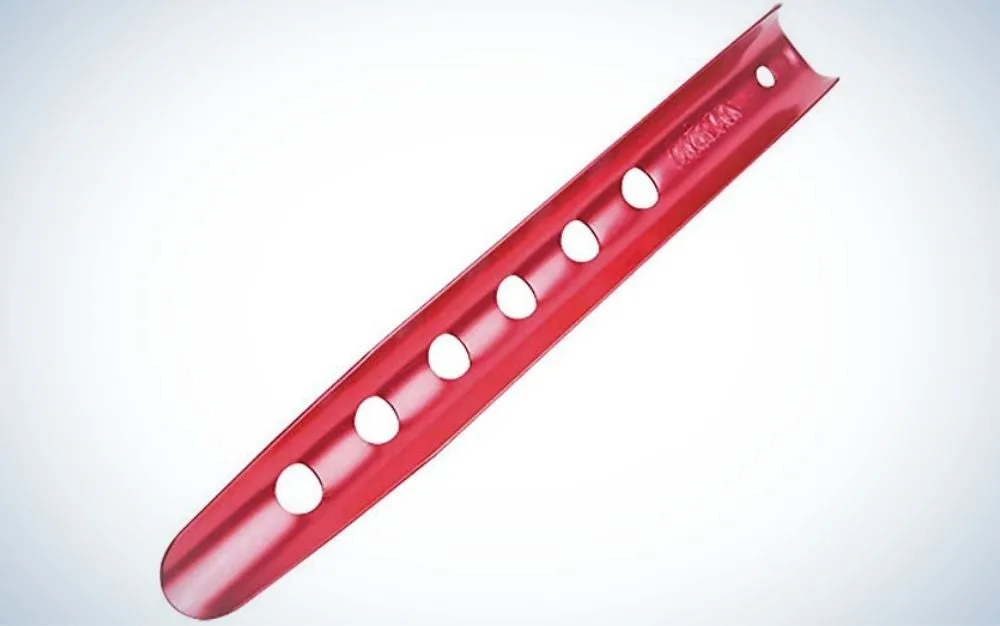
Why It Made The Cut: The MSR Blizzard Stakes are standard snow stakes that can double as a snow anchor when used horizontally.
Key Features
Length: 9.5 in
Weight Per Stake: 1.12 oz
Materials: Aluminum
Pros
Holds in sand as well as snow
Can be used as a deadman achor
Lightweight design
Durable materials
Cons
Limited uses
High price in comparison to other similar designs
The MSR Blizzard Stakes is an excellent choice for folks that enjoy winter or beach camping. These stakes work wonders in snow and sand and can also be utilized as a deadman anchor. Most listings of the MSR Blizzard Stakes sell the stakes as a single unit, not in a pack, so be aware of that as you are shopping. They are more expensive than comparable snow stakes with a similar design.
We chose the MSR Blizzard Stakes as our top pick for snow because of its durability. Many other snow stakes will look similar to this one but won’t be as strong and generally have a higher likelihood of failure. The most comparable in terms of durability and functionality would be the REI Snow Stakes. Despite the price, we still prefer the MSR brand as they are wider and seem to have better holding power.
Best for Hard Ground: Vargo Titanium Nail Peg
Best for Hard Ground
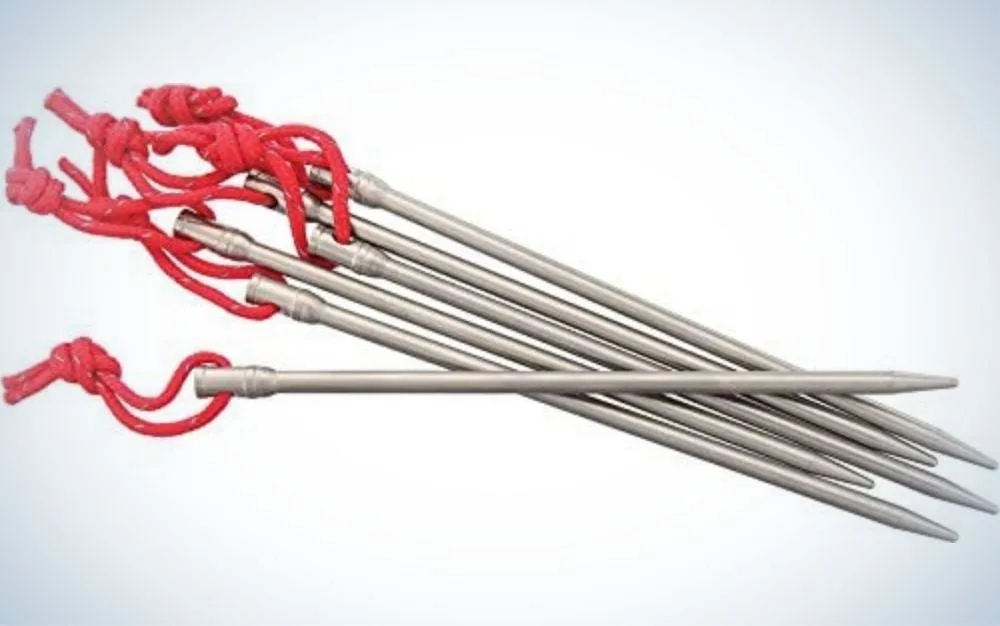
Why It Made The Cut: The Vargo Titanium Nail Peg is a strong yet slender tent stake you can trust even when driving these into hard, compact soil.
Key Features
Length: 10.5 in
Weight Per Stake: 0.6 oz
Materials: Titanium
Pros
Extermely durable
Small and lightweight
Easy to drive into the ground
Cord on top for removal
Cons
Can be difficult to remove from compact soil even with the pull cord
The Vargo Titanium Nail Pegs will get the job done when camping and staking out your tent on compact soil. If you tend to camp in rocky or hard ground areas, you do not want to pass these up. They have a slender design that makes them easier to drive into compact soil.
Since they have a smaller diameter than most tent stakes, they also won’t be as comfortable to drive in with your hand or foot. Anytime you’re setting up a tent on hard ground, it helps to have a hammer on hand anyway, but a rock can work in a pinch.
You can drive these into the ground and just leave the pull cord exposed, but it will be easier to remove them if you leave some of the peg exposed as well. These will likely be hard to withdraw from the ground when utilizing only the pull cord provided. You may have to wiggle the peg around to loosen the surrounding soil for easier removal.
Best Ultralight: MSR Carbon Core
Best Ultralight
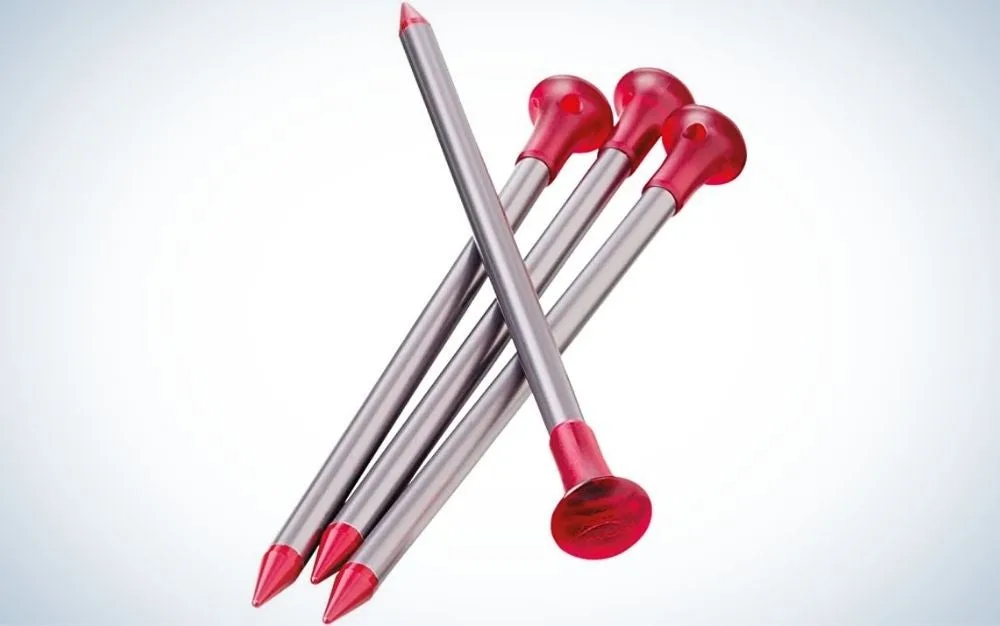
Why It Made The Cut: The MSR Carbon Core tent stakes are a high-quality, durable tent stake that won’t add much weight to your ultralight setup.
Key Features
Length: 6 in
Weight Per Stake: 0.2 oz
Materials: Carbon Fiber and Aluminum
Pros
Lightweight
Strong holding power
Relatively versatile
Durable for the weight
Cons
No pull out loop
High price point
The MSR Carbon Core tent stakes are our top pick for ultralight backpacking. Buy these with fair warning that they need to be used appropriately to be considered long-lasting.
The lightweight does compromise durability when comparing it to other tent stakes, but the carbon core and aluminum exterior do a great job of providing a stronghold for a fraction of the usual weight. Carbon fiber is an expensive material. So if you are confused about the high price, it is because stakes made from carbon fiber or titanium will be much more expensive.
The primary downfall we see with these tent sakes is that they do not come with any pull cord or hook to make it easier to remove them from the ground. The top of the stake does have a slight lip that does help. Just be careful not to drive these all the way down into the ground.
Pair these stakes with some of the best backpacking tents
, and you’ll be set up in no time.
Best Budget: FANBFX Tent Pegs
Best Budget

Why It Made The Cut: The FANBFX Tent Pegs are a durable budget tent stake option that comes in large sets and are compatible with tents, canopies, and other shelters.
Key Features
Length: 7.1 in
Weight Per Stake: 0.6 oz
Materials: Aluminum-Alloy
Pros
Very affordable
Corrosion resistant
Relatively durable for price
Works well even in hard soil
Cons
They will bend easier than other options available
If you are looking for a durable yet budget-friendly tent stake, look no further than the FANBFX Tent Pegs. These are a traditional shepherd’s hood design and are reminiscent of the tent pegs that often come standard with tents.
Although these are a great budget pick, just be aware that they are more prone to bending than thicker alternatives. There isn’t much wrong with these stakes. They do the job, and they do it quite well. Even with a smaller size, they provide decent holding power while still lightweight.
What to Consider When Choosing Tent Stakes
Read through the buying considerations below before checking out our top picks for the best tent stakes. Not only do we outline some of the most commonly used tent stake designs, but considering these things before buying can make it easier to find functional and long-lasting tent stakes.
Intended Use
Tent stakes likely are not your first concern when thinking about tent materials and setup. However, they are essential for a good camping experience, especially when camping in inclement weather.
When buying any outdoor gear, the first considerations should be the intended use and frequency of use. From there, you can move into your budget and other factors. For the intended use of camping stakes, you’re going to use them to secure the tent, so what else is there to consider?
For most people, this will be the type of soil you can expect or whether you’re camping in sand or snow. In some of those circumstances, you can use specialized tent stakes, but you may benefit more from some type of anchor for the corners. The weight and size of the stakes will also be something to consider. For instance, if you are backpacking, the weight of the stakes will be a much bigger deal than if you are car camping. If you aren’t looking to buy tent stakes for yourself but are looking for some of the best camping gifts
for the outdoorsy person in your life, then make sure you know the kind of camping they like to do. Then, start researching based on things like the stake durability and ease of use.
Types of Tent Stakes
Knowing the types of tent stakes can help you narrow down your options. Here are a few of the most common types of stakes you’ll see while shopping:
Nail Pegs: Very identifiable and looks like large nails, typically with a pull cord through the top to make it easy to remove. These are often driven straight into the ground and work well with hammers.
Shephard’s Hook: There are commonly used for stock tent stakes when purchasing a tent. They are made from a straight metal material with a curved hook at the top. While not all stakes of this style will perform the same, with the right materials and diameter, they will be a sturdy stake choice.
Y-Stakes: Instead of being one solid sheath, y-stakes have three edges that go out. It gets the name from the top view of the stake as it appears to be a “y.” These have excellent holding power and are often constructed out of aluminum, making them relatively lightweight.
J-Stakes: Also known as v-stakes, j-stakes are similar to a y-stake, but instead of three edges, there are the only two creating a “v” shape from the top view. Like y-stakes, these stakes will not twist or turn while on the ground, but they are not as strong as a y-stake.
Snow/Sand Stakes: designed for loose soil, sand, and snow, these stakes often have a slight curve but are mostly flat. They will have several holes going up the spine of the stake to help the anchor stay in the loose ground. While they can be used as a normal stake in some circumstances, they can also be buried horizontally to create an anchor in the snow.
There are other varieties of tent stakes, but these tend to be the most common. You may also find spiral stakes when looking at snow or sand stakes. In some instances, securing a tent in snow
or sand can also be done by burying a fabric anchor.
Tent Stake Material
With any piece of gear, even the best camping hammocks
, the materials they are made from matter. Here are the most commonly used tent stake materials:
Steel: steel is standard for heavier car camping stakes. They are strong and won’t bend too easily, but they are not lightweight, so many backpackers choose not to use them.
Aluminum: more popular among backpackers for the affordable price and lightweight design, aluminum is a relatively strong material for tent stakes. These are prone to bending, but they still can hold even when bent. If used properly, they have decent holding power, pack well, and work in various soil types.
Titanium and Carbon Fiber: two newer tent stake materials are titanium and carbon fiber. These are very strong and extremely lightweight, but they are also the most expensive option.
Plastic: as an affordable, budget friendly option, plastic tent stakes can work. Although they can work, plastic is not something we would generally recommend. Some plastic tent stakes are more durable, so look for a sturdy construction or specialty design. If the budget plastic stakes are the only ones you can afford, they will still provide a strong hold when used properly. In most cases, you can use the stock stakes you got with the tent, and they will work better than budget plastic ones.
Weight
For most people, weight isn’t that big of a consideration, but this is an area where the intended use is notable. If you like backpacking, then the weight of gear will be more important for you to pay attention to as you shop.
Even with ultralight tent stakes, you’re likely only saving a few ounces. To some backpackers that count every ounce of weight, this will matter. If you are just starting out, it isn’t as big of a deal, and in all reality, those few ounces won’t matter all that much.
While ultralight gear is accessible and quite lightweight, keep in mind that it also isn’t always as durable. So, when deciding on tent stakes in terms of weight, weigh the pros and cons of the stake as a whole instead of basing it on one technical specification.
FAQs
Q: How do you use tent stakes?
How you use tent stakes will depend on the ground you are securing them into, and the manufacturer recommended instructions. Most tent stakes have the best holding power when driven straight down into the ground, while others may need to go in at an angle. Make sure you leave some of the stake exposed. If the ground is soft enough, push the tent stake in with your hand or foot. Otherwise, you may need to use a stake hammer or a rock to assist you.
Q: Where do you buy tent stakes?
Where you buy tent stakes depends on the type of stake you want. You can go to most big box stores and find some variation of tent sakes, but if you want a particular brand or more variety, you’ll need to go to outdoor retailers or shop online. For the most variety, shopping online is the best option, especially if you are buying from a specific manufacturer.
Q: Can you fly with tent stakes?
You can fly with tent stakes if they are in your checked luggage. If they are in a carry-on bag, they will likely be confiscated when going through security. Tent stakes should be securely wrapped to ensure they do not damage anything. Tent poles should also be in checked luggage only.
Q: How much weight can a tent stake hold?
How much weight a tent stake can hold depends on the stake design and length, soil conditions, and the angle. A stake in hard ground will have more holding power than a stake in loose ground. A longer stake will also have higher holding power. Having the right stake design for the soil or snow type will help increase the holding power. Y-beam stakes will be the strongest for 3-season camping and resist bending when used appropriately.
Q: Can you use a regular hammer for tent stakes?
Yes, you can use a regular hammer for tent stakes. Different hammers may work better than others for the varying tent stake designs. When you are in a pinch, you can also use a rock you find around camp to help you drive the stakes into the ground.
Final Thoughts on the Best Tent Stakes
The best tent stakes are the ones that function well in the environment you’re camping. Having a variety of tent stakes if you camp year-round or in areas with varying soil types can be helpful. The good thing is that most tents is that they come with stakes. While they might not be the most durable or strongest option, they give you a good start. Since different stakes have different applications, get to know what will work best for you before you buy. If you couldn’t find tent stakes you like on our list, go back and reference the buying considerations to help find the best stakes for your needs.
Why Trust Us
For more than 125 years, Field & Stream has been providing readers with honest and authentic coverage of outdoor gear. Our writers and editors eat, sleep, and breathe the outdoors, and that passion comes through in our product reviews. You can count on F&S to keep you up to date on the best new gear. And when we write about a product—whether it’s a bass lure or a backpack—we cover the good and the bad, so you know exactly what to expect before you decide to make a purchase.






